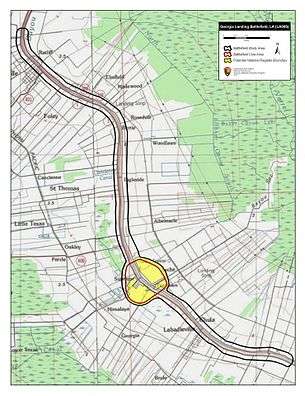Battle of Georgia Landing
The Battle of Georgia Landing (or Labadieville or Texana) was fought October 27, 1862 in Labadieville, Assumption Parish, Louisiana, as part of the Operations in LaFourche District (1862), during the American Civil War.

Background
Maj. Gen. Benjamin F. Butler, commanding Union forces in the Department of the Gulf, launched an expedition into the Bayou Lafourche region to eliminate the Confederate threat from that area, to make sure that sugar and cotton products from there would come into Union hands and to secure it as a base for future military operations. He organized a brigade of about 4,000 men under the command of his protégé Brig. Gen. Godfrey Weitzel to accomplish the missions.
Order of Battle
The Union force consisted of the Reserve Brigade of the Department of the Gulf, 8th New Hampshire Infantry, 75th New York Infantry, and 13th Connecticut Infantry.
The Confederate force consisted of the 18th Louisiana Infantry Regiment, Crescent Regiment, Ralston's Battery, Detachment of Cavalry, 33rd Louisiana Infantry Regiment, Terre Bonne Regiment Louisiana Militia, Semmes's Battery, and 2nd Louisiana Cavalry Regiment (approx. 1,392 men).
Battle
U.S. Army Major General Benjamin F. Butler, commanding Union forces in the Department of the Gulf, launched an expedition into the Bayou Lafourche region to eliminate the Rebel threat from that area, to make sure that sugar and cotton products from there would come into Union hands and, in the future, to use it as a base for other military operations.
U.S. Army Brigadier General Godfrey Weitzel, Butler's protégé, with five regiments from the Reserve Brigade, Department of the Gulf (numbering about 4,000 men), left Carrollton, 7 miles (11 km) above New Orleans, Louisiana on October 24, 1862, and went up the Mississippi River in transports conveyed by gunboats. Reaching Donaldsonville the next day, the troops were disembarked.
On October 25, Weitzel and his men arrived at Donaldsonville, where the Lafourche meets the Mississippi River, and began an advance up the east bank of the bayou. The Confederates, under the command of Brigadier General Alfred Mouton attempted to concentrate to meet the threat.
On the 26th, the Union force marched down the Bayou Lafourche 15 miles (24 km) to Napoleonville, but were unable to find the Confederate force known to be in that region.
By October 27, the Confederates had occupied a position on the bayou above Labadieville. A little more than half the force was on the east bank while the rest of the men were on the west bank near Georgia Landing, generally without means of concentrating on one side or the other.
On the 27th, Union Brigadier General Weitzel continued his march to Labadieville, on the east bank of the bayou, where he found the enemy in considerable force entrenched on both sides of the bayou, with six pieces of artillery in battery. Confederate forces included the 18th Louisiana Infantry Regiment, Crescent Regiment, Ralston's Battery, Detachment of Cavalry, 33rd Louisiana Infantry Regiment, Terre Bonne Regiment of the Louisiana Militia, Semmes's Battery and 2nd Louisiana Cavalry Regiment (approx. 1,392 men).
Gen. Weitzel's troops began skirmishing with Confederate positions on the east bank at about 11:00 a.m. Lacking the artillery support of the troops entrenched on the west bank of the bayou, Confederate troops in these positions retired quickly. By means of a floating bridge Gen. Weitzel began crossing his men to the west bank to attack the Rebel troops there. For some time, these Confederate troops fought resolutely and brought the Union assault to a standstill. However, a lack of artillery ammunition compelled the Confederate forces to abandon these positions as well. Confederate forces retreated up the bayou to Labadieville.
Union losses were 86 including 18 killed and 68 wounded. Confederate losses were estimated at 229. Additionally, 206 Confederates were taken prisoner.
On the 28th Weitzel entered and occupied Thibodaux, a few miles below Labadieville, and on the 29th communication was opened with New Orleans by means of the New Orleans, Opelousas and Great Western Railroad. The result of the expedition was to open the whole region of the Bayou Lafourche to Union occupation.
References
- National Park Service Battle Summary Archived August 17, 2007, at the Wayback Machine
- CWSAC Report Update - Louisiana
- Stanyan, John M., A History of the Eighth Regiment of New Hampshire Volunteers, Including Its Service as Infantry, Second N.H. Cavalry, and Veteran Battalion in the Civil War of 1861-1865, L. C. Evans, 1892.